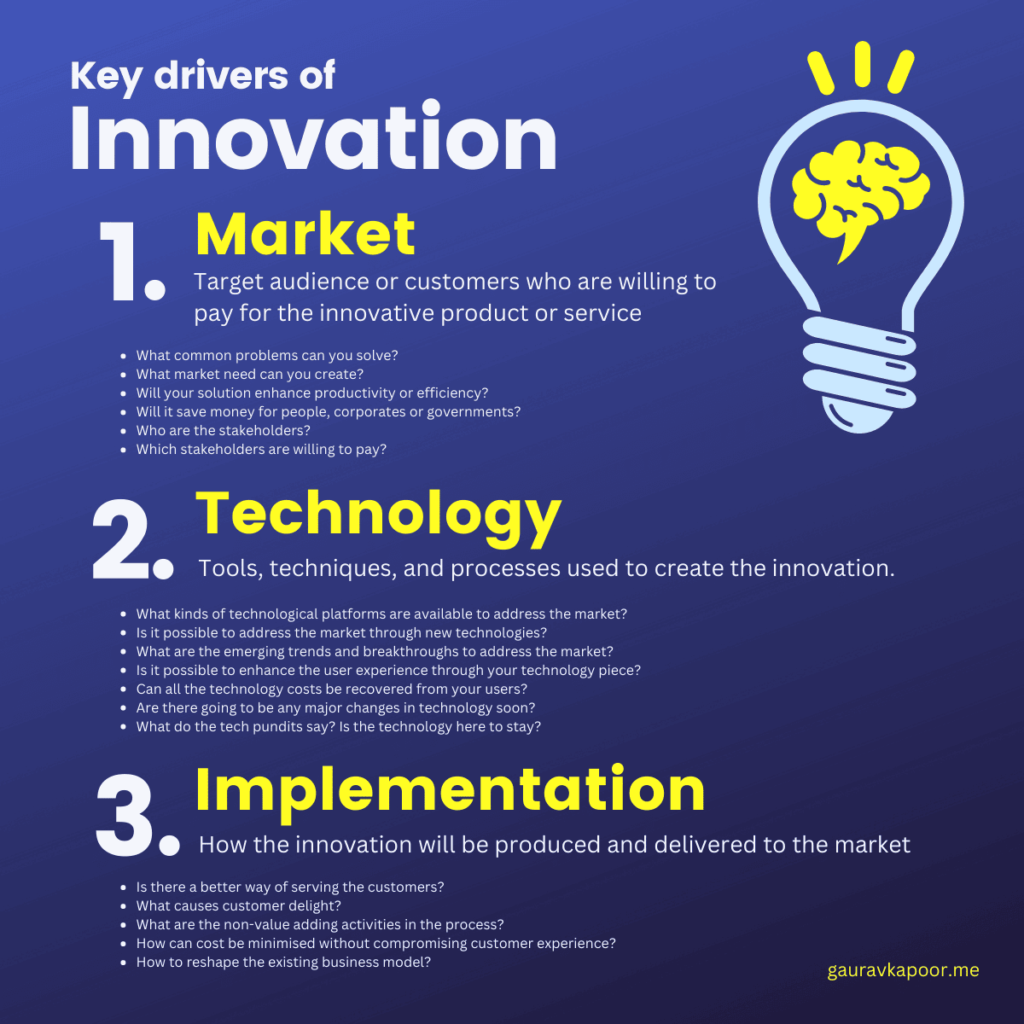Some years ago, I took a course in innovation and commercialisation. This course helped me immensely to think about the innovation process and how it can be used to build better designs for start-ups. So in this article, let me walk you through M-I-T (or MTI or whatever sequence you like) for designing an innovative startup.
What is innovation?
Innovation is the process of creating new ideas, products, or methods, or improving existing ones, in order to solve problems or meet new needs. It is an important aspect of business and economic growth. It allows companies to stay competitive and find new ways to meet the changing needs and preferences of customers. Innovation may involve the development of new technologies. It might mean introduction of new business models or processes. Implementation of new policies or practices also falls under innovation if they can generate additional revenue for the company. Innovation can also involve the combination of existing ideas or technologies in new and creative ways.

What is the difference between innovation and creativity?
Creativity is the ability to generate new and original ideas. On the other hand, innovation is the process of turning those ideas into something useful or valuable. Creativity is a crucial component of innovation. It provides the source material for new products, processes, or ways of doing things.
However, innovation involves more than just coming up with a new idea. It involves the development and implementation of that idea. Successful innovation often involves as the ability to effectively communicate and sell the idea to others.
Creativity is the spark that ignites the innovation process, while innovation is the fuel that powers it forward. Both are important for driving progress and finding solutions to problems. But they serve different roles in the process.
Good time for designing an innovative startup in India
The start-up ecosystem in India is slowly and gradually picking up. Like every cloud has a silver lining, every crisis comes with an opportunity. The volatility of the job market due to recent mass layoffs by tech giants like Meta and Twitter (and recently Google) is expected to fuel and propel the start-up ecosystem much more.
At the same time, is estimated that more than 90% start-ups fail to gather momentum and make it big. However, the associated sense of achievement of creating something unique, to be one’s own boss and to be a source of income generation for others far outweighs the risk of failure. The author himself has failed on a couple of occasions but the drive to keep trying hasn’t diminished one bit. 🙂
The M-I-T of innovation
M-I-T of innovation refers to Market, Implementation and Technology. Innovative start-ups require three main ingredients to thrive – Market, Technology, and Implementation. They are the core important considerations during the innovation process.
Market
The market refers to the target audience or customers for the innovation. Understanding the needs, preferences, and behaviours of the market is essential for creating products or services that will be successful.
Your product or service must address a critical problem and people should be willing to pay for the solution of that problem. In other words, there must be a ‘Market’ which is willing to buy your product or service.
Sometimes companies even create new markets or market needs. For instance, the iPod was a product without any apparent market need. Sony Walkman was doing just fine. However, Apple created the market by offering a sleek, good-looking audio player that could fit comfortably in the jeans pocket and play thousands of songs without having to change cassettes or CDs.
AI based content creators like ChatGPT and Hypotenuse.ai are latest innovations which have carved out a new market recently.
Similarly, the start-up you want to build should address a Market. Key questions that you may want to think about are –
- What common problems you can solve?
- What market need can you create?
- Will your solution enhance productivity or efficiency?
- Will it save money for people, corporates or governments?
- Who are the stakeholders?
- Which stakeholders are willing to pay?
These are some of the questions you should be contemplating – even before dwelling into the Technology part.
Technology
Now that you have identified the problem, think about what technology do you have at your disposal to solve that problem. Technology refers to the tools, techniques, and processes used to create the innovation. Advances in technology can often enable new innovations, and the development of new technologies can also be a source of innovation.

In terms of technology, key questions that you may want to think about are –
- What kinds of technological platforms are available to address the market?
- Is it possible to address the market through new technologies?
- What are the emerging trends and breakthroughs to address the market?
- Is it possible to enhance the user experience through your technology piece?
- Can all the technology costs be recovered from your users?
- Are there going to be any major changes in technology soon?
- What do the tech pundits say? Is the technology here to stay?
For instance, for an App-based setup, think about the user experience – what framework would suit the reliability and scalability needs? Do you want to stick to native (say Android only) or go cross-platform (support iOS, Android, web, etc.)? It is also important to consider the backend services and associated costs.
Implementation
Implementation involves the development and rollout of the innovation. This includes designing and testing prototypes, as well as developing a plan for how the innovation will be produced and delivered to the market. It is important to have an implementation plan in mind. But sort out the market and technology part first before you start diving into the action plans. This will save you a ton of trouble.
If your market and technology assessment are correctly done, implementation shouldn’t be much of a headache. Yet this is the phase where most startups don’t get it right and fail. Your implementation of a business model may be different from that of a competitor. For instance, look at Ola, Uber and In-Drive – all three address the same market. All three use the same technology. Yet they differ slightly in implementation and offer different customer experiences and price points for the same kind of service.
In terms of implementation, here are a few questions you can ponder upon –
- Is there a better way of serving the customers?
- What causes customer delight?
- What are the non-value adding activities in the process?
- How can cost be minimized without compromising customer experience?
- How to reshape the existing business model?
How to nurture innovation
Innovation is crucial for businesses to stay competitive and thrive in today’s fast-paced, constantly-evolving world. You need to design your startup to nurture innovation right from the word go. However, nurturing a culture of innovation within an organization is not always easy. It requires a dedicated effort and the right set of conditions to be in place. Here are some key ways to nurture innovation in your upcoming start-up:
Encourage a growth mindset
Encourage employees to embrace challenges and see them as opportunities for growth, rather than as threats. This can be fostered through training and development programs, as well as through leadership that models a growth mindset.
Innovation is the fuel for growth. When a company runs out of innovation, it runs out of growth.
Gary Hammel, London Business School
Foster collaboration and idea-sharing
Encourage open communication and collaboration among team members, and create channels for employees to share ideas and give feedback. This can be done through regular team meetings, suggestion boxes, and other feedback mechanisms.
Provide resources and support
Give your employees / team members the tools and resources they need to turn their ideas into reality. This might include funding for research and development, access to training and development opportunities, or support from leadership.
Encourage risk-taking
Innovation often requires taking calculated risks. Encourage employees to take risks and embrace failure as a learning opportunity.
If the size of your failures isn’t growing, you’re not going to be inventing at a size that can actually move the needle.
Jeff Bezoz, CEO – Amazon
Foster a culture of continuous learning
Encourage employees to stay up-to-date on industry trends and best practices, and to be open to learning new skills and knowledge. This can be done through training programs, workshops, and other learning opportunities.
Celebrate and reward innovation
Show appreciation for employees’ innovative ideas and efforts, and consider implementing a rewards or recognition program to incentivize innovation.
By implementing these strategies, organisations can create a culture that values and encourages innovation, leading to a more dynamic and successful business.
Conclusion
Together, these three factors – market, implementation, and technology – play important roles in the success of designing an innovative startup. These are the building blocks of future-ready ideas. It is also fruitful to nurture innovation early on during the design stage of your startup. Therefore, it is important to be mindful of these aspects and prepare adequately even before you jump into pitching your breakthrough idea. And for that – I wish you all the best!



